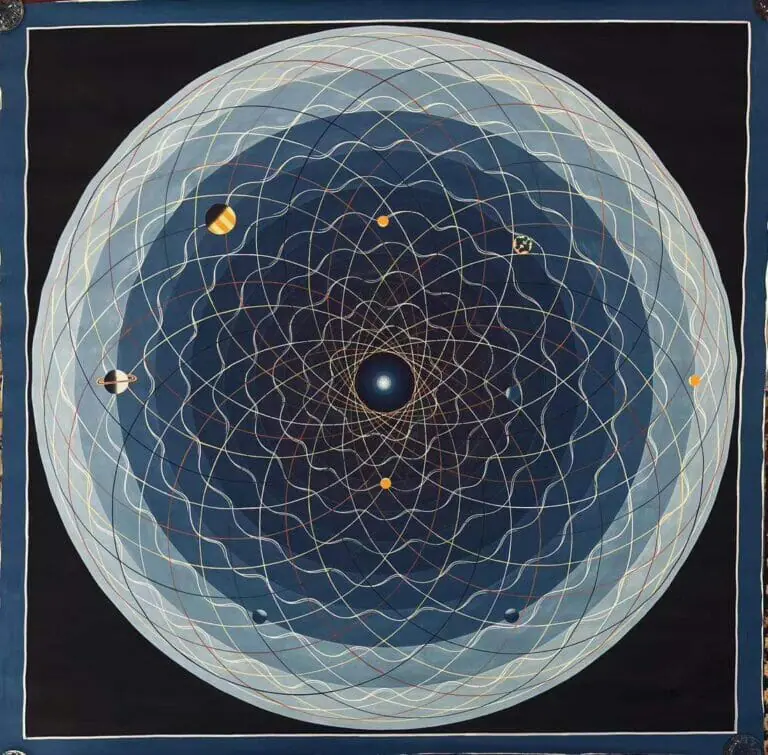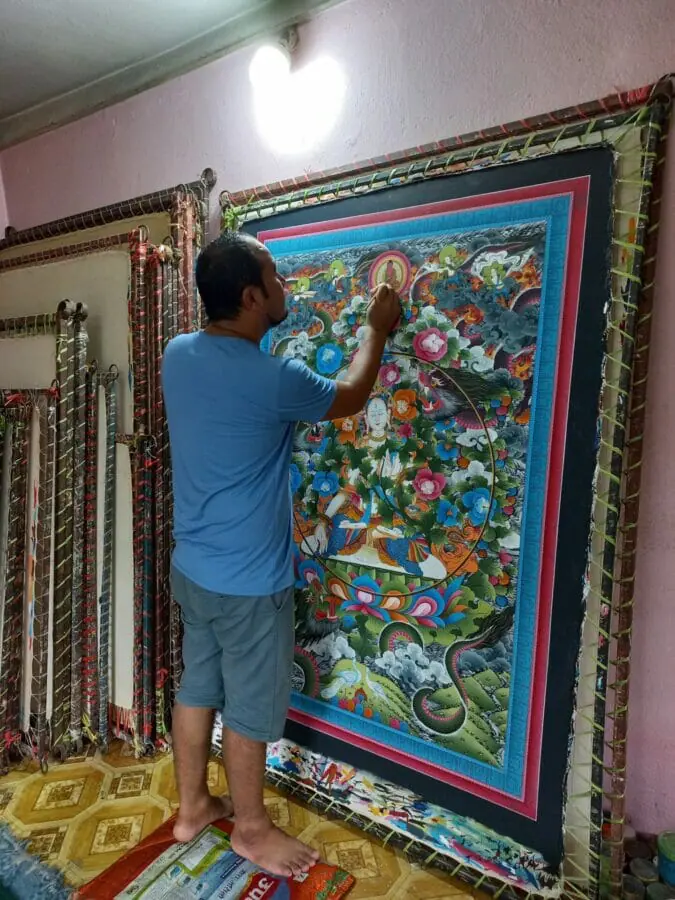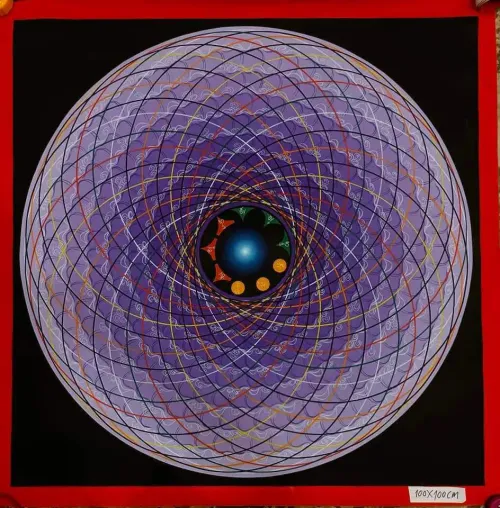The large number of shaktis, “daughters” of the mudras “sacrificed” in the ganachakra, is an indicator of how fundamentally the idea of the tantric female sacrifice determines the doctrine of time and its artistic representation. At the gates which lead out from the fourth segment into the third “mandala of enlightened mind”, we are once again confronted with the symbolic representation of “sacrificial goddesses”. Aside from this, 36 further shaktis, who represent the root syllables of the Sanskrit alphabet and thereby the building blocks of language, live in this building complex.
As the final and outermost segment of the mandala palace we enter the “body mandala”. There we meet the 360 deities of the days of the year. Here too we encounter the basic pattern of the ganachakra. There are twelve large lotuses, each with 28 petals. In the center of each flower a god and a goddess embrace one another, all around them sit 28 goddesses grouped into three rows. Each lotus thus exhibits 30 deities, multiplying by twelve we have the 360 day gods (five days are not calculated). In addition we meet in the body mandala twelve pairs of wrathful deities and 36 goddesses of desire.
We have nonetheless not yet described all the grounds of the palace. The five square architectural units already mentioned are namely bordered by six circular segments. Numerous symbols of bliss like wheels, wish-granting jewels, shells, mirrors, and so on, rest in the arcs (quadrants) which are formed between the last square and the first circle. The five subsequent circles symbolize the elements in the following order: earth, water, fire, wind, and space. Cemeteries are to be found on circles three and four, depicted in the form of wheels. In the imagination they are inhabited by ten horrifying dakinis with their partners. From a Buddhist point of view this “ring of the dead” signifies that only he who has surmounted his bodily existence may enter the mandala palace.

Artwork by Lopsang Lama
The fifth circle of space is represented by a chain of golden vajras. The whole mandala is surrounded by a circle of flames as a sixth ring. According to a number of commentator this is supposed to represent the wisdom of Buddha; however, if we further pursue the fate of the sand mandala, it must be associated with the “world fire” (Kalagni) which in the end burns down the palace of the time gods.
As aesthetic and peaceful as the sand mandala may appear to be to a Western observer, it still conceals behind it the frozen ornament of the sacrificial ritual of Tantrism. Every single female figure which inhabits the palace of time, be she a dakini, shakti, or a “sacrificial goddess”, is the bearer of the so sought after “gynergy” which the yogi has appropriated through his sexual magic practices so as to then let it flow as the power source of his androgynous mystic body. The Kalachakra palace is thus an alchemic laboratory for the appropriation of life energies. In the ritual fate of the sand mandala we shall unmistakably demonstrate that it is a gigantic sacrificial altar. It is not just the shaktis who are sacrificed, but the erotic couples as well, who delight the temple with their untroubled pleasures of love, indeed the time god (Kalachakra) and the time goddess (Vishvamata) themselves. The downfall of them all is preordained, their fate is sealed.
Embedded iFrame
The Construction Of The Kalachakra Sand Mandala
The construction of the Kalachakra sand mandala is a complex and multilayered procedure which is carried out by a number of specially trained lamas. The “master builder “ of the diagram and the spiritual leader of the Kalachakra initiation need not always be the same person. They are so to speak the assistants of the tantra master. Nonetheless, at the outset the latter makes the following appeal to the time god: “Oh, victorious Kalachakra, lord of knowledge, I prostrate myself to the protector and possessor of compassion. I am making a mandala here out of love and compassion for my disciples and as an offering in respect to you. Oh Kalachakra, please be kind and remain close to me. I, the vajra master, am creating this mandala to purify the obstructions of all beings. Therefore, always be considerate of my disciples and me, and please reside in the mandala” (quoted by Bryant, 1992, p. 141).
The grounds sought out for the ritual are now subjected to a rigorous examination, the so-called “purifying of the site”. Monks investigate the ground, measurements are taken, mantras and sutras are quoted. Subsequently it comes to a highly provocative scene, in which the local spirits and the earth goddess are violently forced to agree to the construction of the mandala.
For this purpose one of the lamas takes on the appearance of Vajravega, that is, he visualizes himself as this deity. Vajravega is blue in color, has three necks and 24 hands. As clothing he wears a tigerskin skirt, decorated with snakes and bones.

Artwork by Lopsang Lama
About
Lopsang Lama is a traditional Tibetan artist. You can follow his artwork on Facebook and order his beautiful work directly from him. Find a masterpiece of sacred art to inspire for a lifetime: lopsanglama331@gmail.com

External Resources
Tradition Of The Sand Mandala
Tibetan Sand Mandala
Exploring The Mandala
